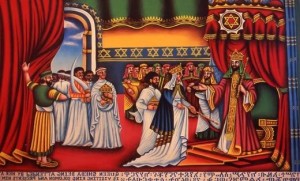Ethiopia is a region that has a long history, has some of the earliest human populations and possibly the region where people expanded and evolved out of Africa to populate the rest of the world 1.8 years ago. The period begins with the Australopithecus, the ancient hominoids which extend to the early inhabitants of the pre-Aksumites. It is also the period with the arrival of Ge’ez and Judaism. It is believed that the Cushitic language speakers have been the original inhabitants of Ethiopia; however, they were driven out of the region in the 2nd millennium B.C. Accordingly, the Ethiopian kingdom was founded (10th cent. B.C.) by Solomon’s first son, Menelik I. However, it is documented that the first kingdom was Aksum (Axum), a kingdom that probably emerged in the 2nd century A.D. The First Ethopian Kingdom, Aksum was a very advanced civilization, for they were the first Africans to mint coins. Nevertheless, Ethiopia is the oldest independent country in Africa and one of the most ancient nation in the world.
Under King Ezana, Aksum was converted (4th cent.) to Christianity by Frumentius of Tyre. This is closely tied to the Egyptian Coptic Church, and it accepted the Monophysitism, a Christological position that Christ has only one position, following the Council of Chalcedon. In the 6th century, however, the Jewish influenced the Aksum, and some Ethiopians were converted to Judaism. The second Ethopian Empire was The Zagwe; they didn’t claim the King Solom nor the Queen of Sheba. When Yekuno Amlak came to power, the Solomonic Dynasty was reinstated in the 10th century BC. Then came, the Zamana Masafent era, which was marked with continuous welfare. It was a period in which Ethiopia was divided with no effective central authority. The lords constantly fought against each other to become the guardians of the kings of kings of Gonder. A notable figure of this period is the monastic evangelist Ewostatewos, who was an important religious leader in the Ethiopian church. Finally the modern Ethipoia was the reunification of Ethiopia, which began with the rule of Emperor Tewodros. The next major ruler was Haile Selassie I before Derg replaced him.
Nevertheless, Ethiopia consists of number of religion, which includes mainly Abrahamic religions, Orthodox Christianity, Islam, and Judaism. Ethiopia is developing a $45 million information technology park to boost the economy, and to advance the academic aspect of the country since this park will attract much more research and development of the country. By establishing the technology park, the Ethiopian government is seeking to attract global businesses, which includes call-centers and computer hardware. By doing so, they will be able to have access to Internet speeds of as much as 40 gigabytes a second.
I believe that there is sufficient information regarding the ancient history of Ethiopia. Some of the sources include: BBC, www.ethiopiantreasures.co.uk, books, and scholarly articles. Also the sources delineate the history of Ethiopia clearly and sufficiently, which makes it easy to understand the content and to grasp the information.



